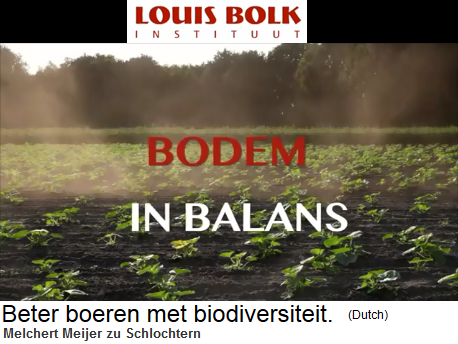Managing soils to protect biodiversity
Soil organisms are widely neglected in conservation efforts. All too often, they are ‘out of sight and out of mind’. However, understanding the aboveground-belowground linkages, and given the multiple threats to soils as outlined in the previous sections, it is our responsibility, to preserve the quality of soil before it is too late, and before its resident species and their fragile habitats are lost.
It is not surprising that soil management has a direct impact on biodiversity – including practices that influence soil volume and structure, or biological and chemical characteristics, One can even say that managing soil biodiversity is (at) the root of sustainable agriculture! Farmers, as custodians of much of the land, can play a crucial role in protecting soil biodiversity, since their choice of tools and techniques has an enormous influence on belowground biodiversity.
Farming for soil biodiversity may include, but is not restricted to:
- Mulching, or covering soil, for example with crop residues or compost; this helps retain heat, preserve moisture and prevent erosion. Organic mulches can be broken down by soil organisms and help to improve soil structure, as well as sustain micro-organisms.
- Applying organic residues (crop residues, manure, compost) to the soil; this provides food for soil organisms. In combination with reduced tillage intensity, this promotes ecosystem engineers that restore water infiltration and prevent erosion.
- Crop choice is also significant; legumes (peas and beans) act as natural fertilisers as they help fix nitrogen in soil. Rotating the type of crops planted can help prevent the build-up of pathogens and pests, and preserve nutrients in the soil.
The beauty of the above measures is that they also help to combat another major driver, climate change. By fixing or ‘sequestering’ organic carbon in soils, they contribute to fight increasing atmospheric CO2 levels. Many more technologies and approaches exist. If you are interested in this topic, have a look at the WOCAT database. It comprises ‘best practice’ examples in the field of sustainable land management (SLM) from over 50 countries in all climatic regions of the world.
Awareness about the vital importance of soil biodiversity is also increasingly recognised by policy makers. A Soil Thematic Strategy has been formulated by the European Commission in 2007. It lead to a State of Soil in Europe report (2012) that also covers soil biodiversity; and it is hoped that a European Soil Framework Directive will be in place soon. At an even higher level, the Global Soil Biodiversity Initiative (GSBI) was launched in September 2011. This is a scientific effort to develop a comprehensive course of action and bring global awareness of ecosystem services provided by soil biodiversity.
Taking steps to protect soil species may be doubly useful: while measures to protect above-ground species do not necessarily help below-ground biodiversity, efforts to protect soil communities are very likely to help conserve endangered plants and animals that are better-known. Policies that target soil biodiversity directly or indirectly by protecting their environment could therefore have a much greater impact than anticipated.
